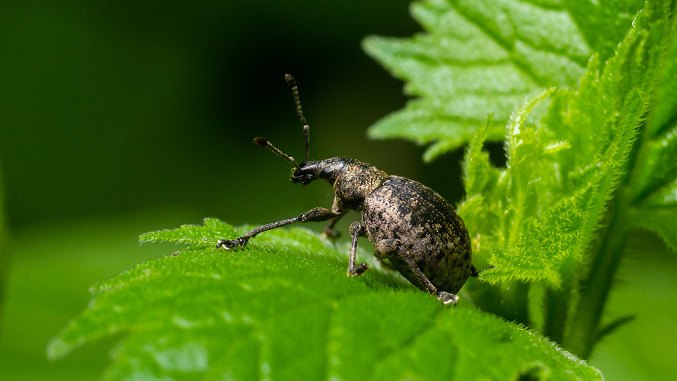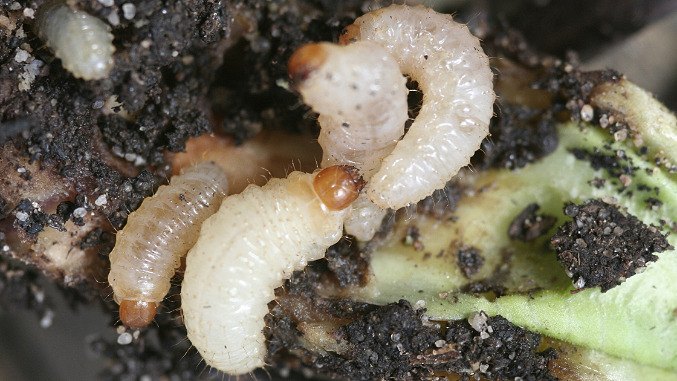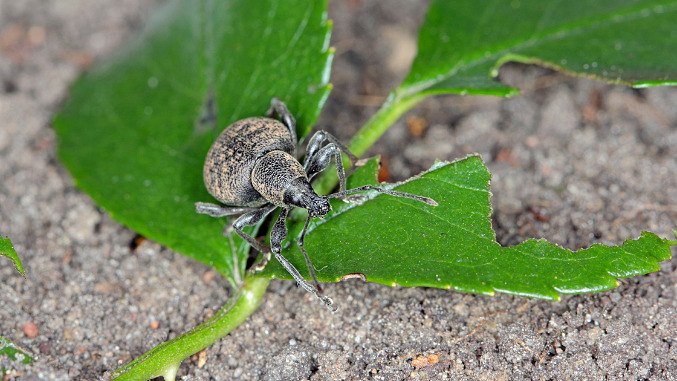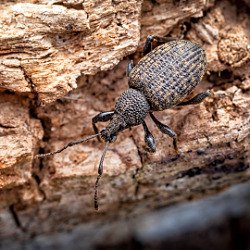
Bug of the month April: Black vine weevil
2 Minute Read
Dr Ian Bedford tells us everything we need to know about the 'bug of the month' for April, black vine weevil.What are black vine weevil?
The Black vine weevil, Otiorhynchus sulcatus, is a flightless, 1cm long beetle that is native to Northern Europe. It is regarded as a serious plant pest, causing damage to over 200 different plant types, which include ornamentals, broadleaf shrubs, conifers and soft fruits.
Black Vine Weevil adults are easily recognised, by their oval shape and the small patches of short dull-yellow hairs on their fused black wing cases. They also have a characteristic pair of elbowed antennae which are attached to a long snout (their rostrum).

When are black vine weevil active and what is their lifecycle?
Adult vine weevils are active from May to October, when they’ll be found feeding nocturnally on leaves, creating distinctive notches around the leaf edges. During the day, the weevils remain hidden amongst garden debris, usually underneath the plants that they have been feeding on.
Although the leaf damage caused by the weevils will be unsightly, it is unlikely to affect the health or vigour of an established plant. However, the distinctive leaf notching caused by the adults, will often be a sign that vine weevil larvae are present too.
This is because all Black Vine Weevil adults are parthenogenetic females that can lay fertile eggs without having to mate with a male. So, around the plants where the adults are feeding, they are likely to be laying several hundred tiny spherical brown eggs into the soil, throughout late Spring and Summer.
The larvae that hatch from these eggs (also known as grubs), are C-shaped with cream coloured bodies and pale brown heads, and they spend their entire time underground, feeding on roots, bulbs, corms and the basal stems of many different plants within borders, pots and containers.
Unlike the adults, their feeding damage will often be severe and can result in stunting, wilting and even plant death where infestations are high, especially from September through to March when the larvae will be fully grown, and even during winter, where the larvae remain active amongst the roots of frost-protected plants.

So, is it possible to effectively control infestations of adult vine weevils in our gardens?
Well, eradicating them from flowerbeds and borders, especially where susceptible trees and shrubs are incurring leaf damage, will be virtually impossible, since there are likely to be large numbers of adult weevils in the location, and they’ll be hidden within nooks and crannies and amongst garden detritus throughout daytime.
However, their numbers could certainly be reduced by shaking the branches of the affected trees and shrubs during the evening and over a white sheet. This easily dislodges the adults when they are feeding on the leaves and will enable them to be collected on the sheet below.

How to control vine weevil numbers
Controlling vine weevil larvae will also be difficult within open garden flower beds since they will be living amongst the plant roots and usually inaccessible. However, treating them with a drench of entomopathogenic nematodes by watering them into the soil around the base of affected plants may help to reduce their numbers.
Reductions in infestations can also occur naturally by encouraging predatory creatures, such as toads, ground beetles and centipedes into the affected locations. Simply by not using chemicals and by mulching the area with organic matter and pieces of tree bark.
Using dried mealworms to attract insectivorous birds such as robins and blackbirds to the affected areas will also help. Eradicating vine weevils from potted plants though, can be much easier, and it’s best done from Autumn to early Spring when the grubs are almost mature and easily seen.
Simply remove the affected plants from their pots, dispose of the old compost and then, after checking for grubs amongst the roots, re-pot the plants into fresh clean compost.
Applying a non-absorbent, granular ‘Pot-Topping’ to the compost, such as horticultural grit or a crushed olive pomace-based product will then deter the adult weevils from laying eggs into the pots when they emerge in late Spring. Pot Toppings can also be used in conjunction with treatments of entomopathogenic nematodes.

Vine weevil controls
Our natural pest controls are simple to release and effective. Each work similarly, click on the link below to learn more about how to utilise them in your garden.find out more

About Dr Ian Bedford
Ian has been fascinated by the bug world for as long as he can remember. From studying butterflies on the South Downs as a youngster, he went on to pursue a career in Research Entomology and ran the Entomology Dept at the John Innes Centre in Norwich up until his recent retirement. Ian now works as an independent entomologist offering advice to companies developing environmentally safer plant protection products.find out more
Comments (0)
Why not be the first to send us your thoughts?
Leave A Comment
Most popular articles
1
Plastic plant pots dimensions and uses2
Peat vs Peat Free - Choosing the right Potting Compost3
How to Grow Watercress at home in plant pots4
January Jobs5
Our guide to seed sowing compost